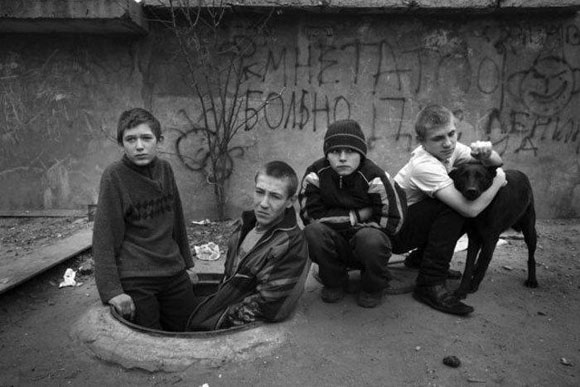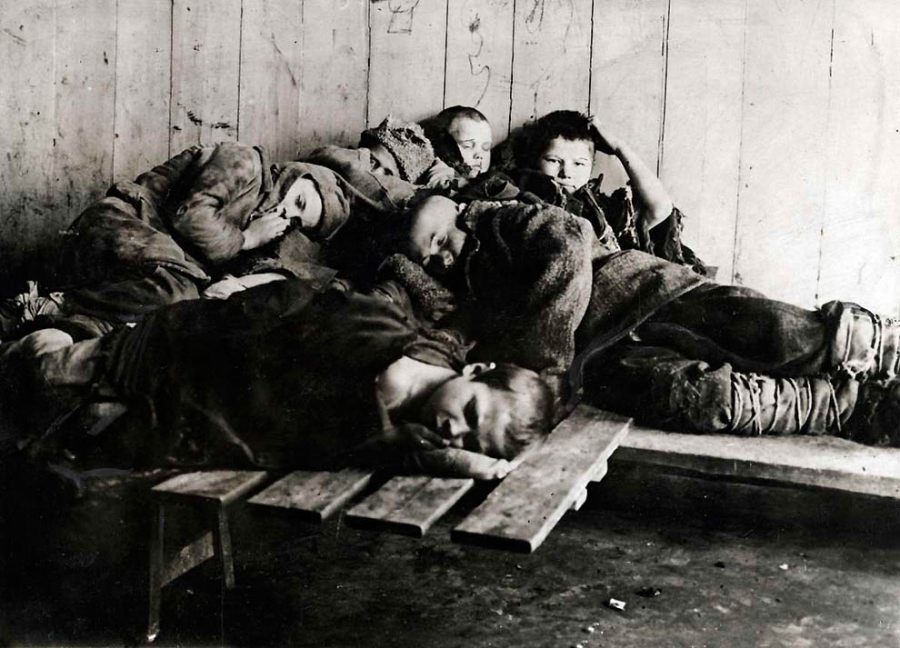Today, the number of homeless children in Russia is estimated to be between one and five million. Despite these shocking figures, the issue hardly appears on the political or public agenda. While government policy toward homeless children continues to be executed sporadically and essentially irresponsibly, the proportion of the Russian population living outside the law continues to grow, portending the possibility of a future crisis. IMR's Olga Khvostunova reports on youth homelessness in Russia today.

The prevalence of homeless children is a social and cultural phenomenon that generally arises during periods of acute social, economic, and political instability, such as international military conflicts, civil wars, famines, and in the wake of natural disasters. In the modern world, this phenomenon is most commonly related to economic crisis and the prevalence of poverty, domestic violence, and child abuse. Problems such as these cause guardians to kick children out or bring about children running away voluntarily.
A critical mass of homeless children is, unequivocally, a symptom of erosion at every level of society, from family structures to major government institutions. Experts attest that it marginalizes adults and children that live outside of the status quo. One of its greatest dangers is that children who live on the streets, surviving off money they usually acquire illegally, tend to form subcultures, developing worldviews and values that contradict traditional norms.
They have their own laws and morals, their own justice and reprisals. They travel a lot, but don't see much. They are not aggressive, but they are suspicious. They like ice cream and Coca Cola. I would ask them about their future. They didn't know how to respond because they don't think about it. They don't believe they have a future.
Award-winning photographer Sergey Maksimishin
In the long term, the prevalence of homeless children leads to the growth of the crime rate, drug abuse, and HIV incidence, thus undermining the foundations of society at large. Some even point out that child homelessness rates are the indicator of the level of national degeneration.
History
The phenomenon of homeless children has affected almost every country at one time or another. For example, in 1848, it was documented in Britain by Lord Ashley, who, as head of the British Mine Commission, reported that in and out of London, there were at least 30,000 “naked, filthy, roaming lawless and deserted children.” Despite the pervasiveness of this social ill, up until now, there has been no precise, universally-accepted definition of ‘street child’. The general understanding is that this refers to a child who lives on the street, separate from their family, and not controlled by adults in any way. In Russia, there is also the term ‘neglected children’ (beznadzornie), which refers children who communicate with their guardians, but spend most of their time outside of their homes, on the street. The English terms ‘street children’ and ‘homeless children’ cover both meanings.
The vague terminology is part of the reason there is no accurate statistical data on homeless children worldwide. According to a 2005 UNICEF report, the estimated number is around 100 million. China, India, Brazil, Pakistan, the Philippines, and Russia are currently among the countries where the issue is most acute.
It's impossible to say for sure how many children live on the streets of Russia, since even official estimates vary greatly – from 1 million to 4-5 million (based on the data from the Ministry of Education, Ministry of Internal Affairs, and various NGOs). According to the Prosecutor General’s Office, in 2010, 2.17% of Russian children were homeless, which would put the number at 600 thousand. Compared to 2001, the number has doubled in the past ten years alone.
Homeless children are not new for Russia. A great number of them flooded the streets of Russian cities during the First World War (1914-18). The problem only grew worse after the Russian Revolution of 1917, and further deteriorated during the civil war (1917-23). According to various estimates, in the early 1920s, there were between 4.5 and 7 million homeless children in Russia.

Homeless children. Moscow, 1930s.
It was impossible to ignore these outrageous numbers, so the young Soviet government turned the fight with child homelessness into a political priority. Due to the task’s complexity, the efforts took almost ten years to be successful, and measures that were not entirely humane had to be implemented to this end.
The Council for the Protection of Children, formed in 1919 and led by Anatoly Lunacharsky, the People’s Commissar of Enlightenment, was the first Soviet organization to tackle the problem of homeless children. This organization’s two major objectives were feeding children and providing them with medical services. Two years after its foundation, the Council joined efforts with the Commission on the Improvement of Children’s Lives, overseen by the Director of the Cheka, Felix Dzerzhinsky. In 1925, Dzerzhinsky created a public organization called Friends of Children, which aimed at fighting illiteracy among the homeless. It also helped homeless children search for family members and oversaw orphanages. Bureaus for the social and legal protection of minors were created in many schools across the country. During the 1920s, hundreds of child welfare institutions such as emergency shelters for young orphans (doma rebyonka), orphanages, and special boarding schools, were founded; the first working labor colonies and labor communes were created around the same time, as well. With these joint efforts, by the end of 1928, the official number of homeless children in the USSR was down to 300 thousand. In 1935, the Council for the People’s Commissars reported that mass youth homelessness had been eliminated.
The second peak of the child homelessness in the USSR came during the Second World War. From 1941 to 1945, the number of the children living on the street grew from 220 to 800 thousand. The responsibility for resolving the issue was placed in the hands of the People’s Commissariat for Internal Affairs (NKVD). One of their measures was the establishment juvenile delinquency divisions. The police were supposed to detain homeless children, bring them to police stations, and register them. Shelters for such children were also established at the same time. Detained homeless children were allowed to spend up to two weeks at such shelters, during which time the police would try to contact their parents and find out if the child could be returned to his or her family. If it was impossible, children under 14 were placed in orphanages or special boarding schools; those over 14 were sent to work at industrial or agricultural enterprises.
After the war, the Soviet system for supervising orphan children consisted of the following: First, children were brought to shelters. Newborns and toddlers up to 3 years old would be placed in emergency shelters for young orphans (doma rebyonka), while older children (ages 4 through 17) would be sent to orphanages and special boarding schools. If a child had disabilities, he or she would be institutionalized in a special care or psychiatric facility. After reaching the age of 18, graduates from the orphanages and boarding schools were left to their own devices, while the disabled were transferred to special care institutions for adults.
Although this system seemed to work well, many today point out that in the Soviet times, information on the incidence of child abuse, drug addiction, and suicide was suppressed. The government didn’t recognize domestic violence or abuse in special care institutions. Another problem was that the Soviet police did little for children who had allegedly run way from their families. If a parent was located, the police would send them home without questioning them or investigating the possibility of domestic violence, abuse, or neglect. There were no therapy or rehabilitation programs for abused children who were subsequently victimized by street life.
Since the early 1990s, Russia has seen a new wave of youth homelessness. The collapse of the Soviet Union and the social and economic crisis that followed has led to major cutbacks in government spending on education, including after-school programs, school health centers, summer programs, and centers for extracurricular activities. The rate of alcohol and drug abuse among teenagers has increased dramatically, as have delinquency and suicide rates, which are likely related to the growing incidence of domestic violence. By the mid-2000s, government spending on education per child dropped to half of the rate in 1990. Experts estimate that over 1.5 million children currently do not attend school.







